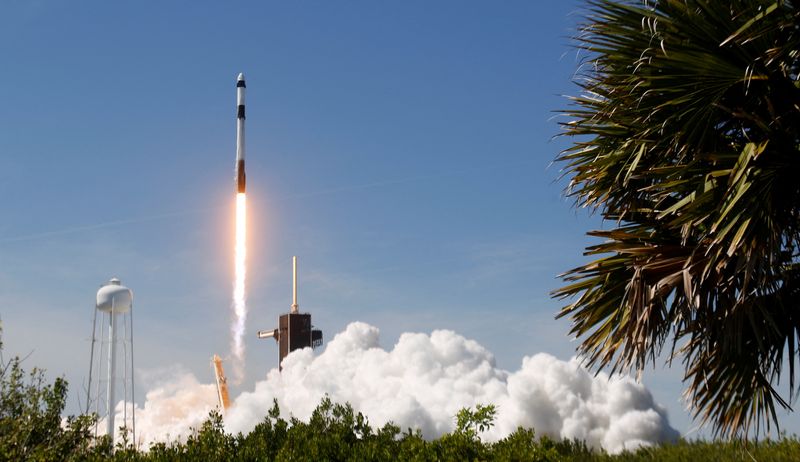
© Reuters. FILE PHOTO: Axiom’s four-man team lifts off, riding atop a SpaceX Falcon 9 rocket in the first private astronaut mission to the International Space Station, from NASA’s Kennedy Space Center in Cape Canaveral, Florida, U.S. April 8, 2022. REUTERS/Steve Nes
By Steve Gorman
(Reuters) – The first all-private astronaut crew to fly aboard the International Space Station (ISS) headed for splashdown Monday off the coast of Florida, wrapping up a two-week mission that NASA has touted as a landmark in commercial spaceflight.
A SpaceX Crew Dragon capsule carrying the four-man team of Houston-based startup Axiom Space Inc began its return flight about 9 p.m. EDT Sunday (0100 Monday GMT) as it undocked from the space station orbiting about 250 miles (420 km) above Earth.
The Crew Dragon was expected to parachute into the Atlantic around 1 p.m. EDT on Monday (1700 GMT), capping a 16-hour ride home from orbit that had been postponed for several days because of unfavorable weather.
The multinational Axiom team was led by Spanish-born retired NASA astronaut Michael Lopez-Alegria, 63, the company’s vice president for business development. His second-in-command was Larry Connor, 72, a technology entrepreneur and aerobatics aviator from Ohio designated the mission pilot.
Joining them as “mission specialists” were investor-philanthropist and former Israeli fighter pilot Eytan Stibbe, 64, and Canadian businessman and philanthropist Mark Pathy, 52.
Launched from NASA’s Kennedy Space Center on April 8, they spent 15 days aboard the space station with the seven regular, government-paid ISS crew members: three American astronauts, a German astronaut and three Russian cosmonauts.
The ISS has hosted several wealthy space tourists from time to time over the years.
But the Axiom quartet was the first all-commercial team ever welcomed to the space station as working astronauts, bringing with them 25 science and biomedical experiments to conduct in orbit. The package included research on brain health, cardiac stem cells, cancer and aging, as well as a technology demonstration to produce optics using the surface tension of fluids in microgravity.
Axiom, NASA and SpaceX have hailed the mission as a milestone in the expansion of privately funded space-based commerce, constituting what industry insiders call the “low-Earth orbit economy,” or “LEO economy” for short.
It was the sixth human spaceflight for SpaceX in nearly two years, following four NASA astronaut missions to the ISS and the “Inspiration 4” flight in September that sent an all-private crew into Earth orbit for the first time, though not to the space station.
SpaceX, the private rocket company founded by Tesla (NASDAQ:) Inc electric carmaker CEO Elon Musk, has been hired to fly three more Axiom astronaut missions to ISS over the next two years. The price tag for such outings is high.
Axiom charges customers $50 million to $60 million per seat, according to Mo Islam, head of research for the investment firm Republic Capital, which holds stakes in both Axiom and SpaceX.
Axiom also was selected by NASA in 2020 to build a new commercial addition to the space station, which a U.S.-Russian-led consortium of 15 countries has operated for more than two decades. Plans call for the Axiom segment to eventually replace the ISS when the rest of the station is retired around 2030.
Stay connected with us on social media platform for instant update click here to join our Twitter, & Facebook
We are now on Telegram. Click here to join our channel (@TechiUpdate) and stay updated with the latest Technology headlines.
For all the latest Business News Click Here
For the latest news and updates, follow us on Google News.
